Morris & Fan. Reservoir Sedimentation Handbook
Подождите немного. Документ загружается.

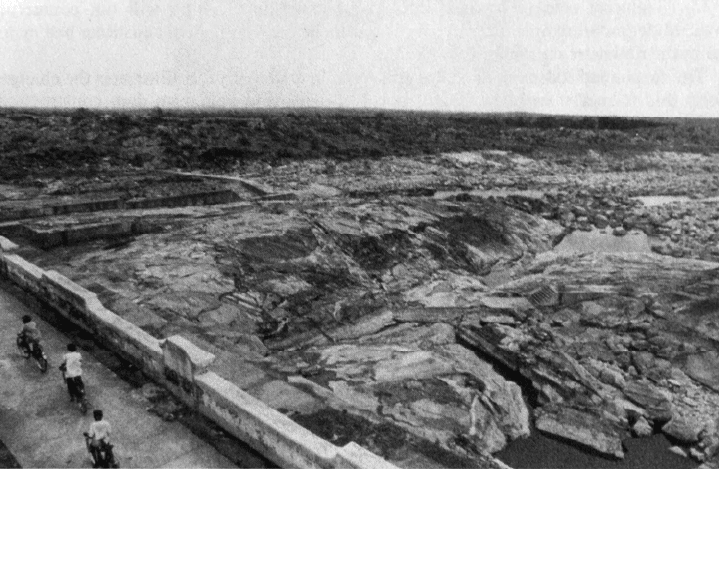
ENVIRONMENTAL AND REGULATORY ISSUES 18.9
compared against conditions in the pre-impoundment river or the modified post-
impoundment river. The selection of a baseline condition for impact assessment will
have considerable bearing on the methodology and results of impact analysis, and
should he considered carefully.
Increased levels of suspended sediment impact downstream aquatic ecosystems.
Periphyton, algal growth on submerged surfaces, is the base of the aquatic food chain in
many streams, and many benthic invertebrates graze periphyton. Increased suspended
sediment levels reduces light penetration and photosynthetic activity. High levels of
suspended sediment in conjunction with high discharge can scour algae off
streambed substrates. Grazing benthic invertebrates can be impacted by reduced food
supply (periphyton), and filter feeders are affected because suspended sediment can
clog feeding structures and reduce food intake, thereby stressing or killing the
organisms. Benthic invertebrates may also be damaged by scour, and all benthic
organisms can be smothered if a significant amount of sediment is deposited on the
stream bottom. Suspended sediment affect salmonid fishes by: (1) stressing or
killing living fish, (2) interfering with development of eggs or larvae, (3)
modifying movement and migration, and (4) reducing the food supply. The stress to
which aquatic organisms are subjected is related to both the suspended sediment
concentration and the duration of exposure (Newcombe and MacDonald, 1991).
18.2.5 Morphologic Impact Downstream of Dams
Stream morphology below dams is affected by both the interruption of sediment
transport and the reduction in peak discharge. The typical pattern is for the
streambed to incise and become armored below the darn in response to the elimination
of bed material load. The zone immediately below the spillway or outlet works may be
scoured to bedrock (Fig. 18.4), and structures on alluvial material below dams may
Figure 18.4. Photograph of area of scoured bedrock immediately downstream of Nizam Saga
r
Dam, Andhra Pradesh, India (G.Morris).
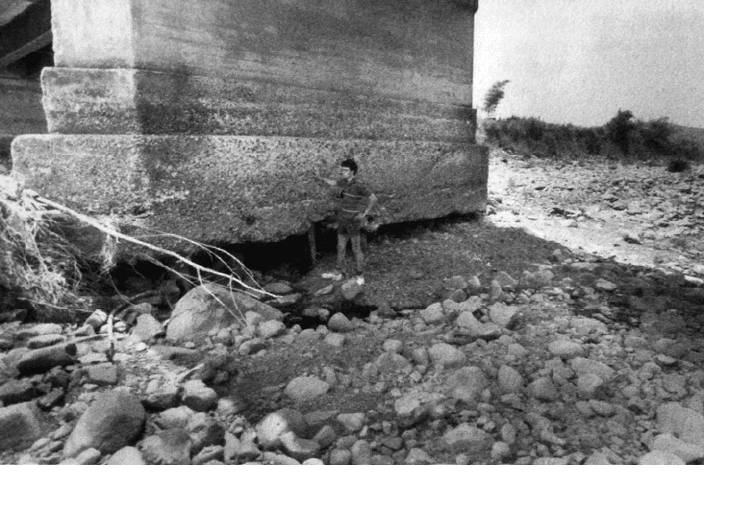
ENVIRONMENTAL AND REGULATORY ISSUES 18.10
FIGURE 18.5 Streambed degradation and resultant bridge scour about 2.5 km below Patillas Dam,
Puerto Rico (G. Morris).
B
e subject to damage by scour (Fig. 18.5). Armoring and degradation can extend for tens
or hundreds 3f kilometers downstream as the sediment-deficient river entrains material
from the streambed and banks. The armored bed below Dos Bocas Dam is shown
in Fig. 18.6. Bed degradation extended 300 km below Sariyar Dam in Turkey
(Simons and Senturk, 1992). Sediment release by pass-through or reservoir
flushing will not counteract riverbed degradation unless it discharges sediment
large enough to constitute bed material in the downstream reach.
The suspended sediment load along the Nile in different years illustrates the changes
along this formerly sediment-laden sand-bed river resulting from dam
construction. Under pre-impoundment conditions, the river deposited sediment
moving downstream during the annual flood. After dam construction, year-round
releases of clear water resulted in sediment loads that were very low, but increased
moving downstream as the clear water entrained sediment from bed and banks (Fig.
18.7). Degradation along the Nile has been limited to less than a meter in the 27
years following dam construction because of factors such as the reduction in peak
flood discharge, armoring, and the presence of several barrages along the length of
the river which provide grade control (Hammad, 1972: Moattassem and
Abdelbary, 1993). The amount of bed degradation along the Nile has been lower
than predicted by a number of different researchers (Shalash, 1983). In other cases
the rate and amount of degradation below a dam can be significant.
The impacts of dam construction on stream channels below dams were analyzed by
Williams and Wolman (1984) on the basis of pre- and post-impoundment
measurements at 287 cross sections below 21 dams on alluvial rivers, mostly
located in the semiarid area of the western United States. Bed degradation varied
from negligible to about 7.5 m at the studied cross sections, with most degradation
occurring during the first 10 or 20 years after dam closure. Trends in channel
degradation at streamgage stations are illustrated in Fig. 18.8, showing that
channel changes proceed irregularly over time at some sites, and proceed regularly at
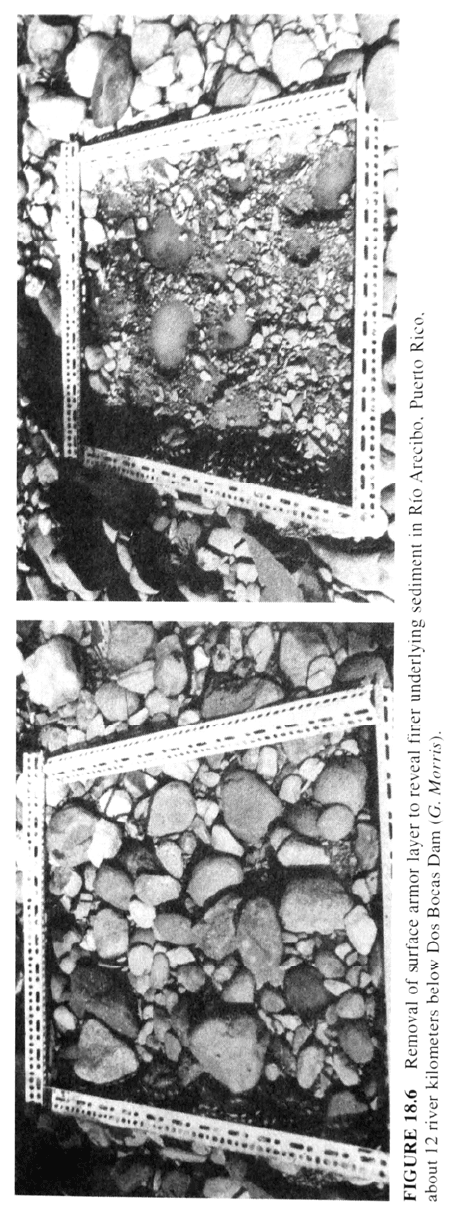
ENVIRONMENTAL AND REGULATORY ISSUES 18.11
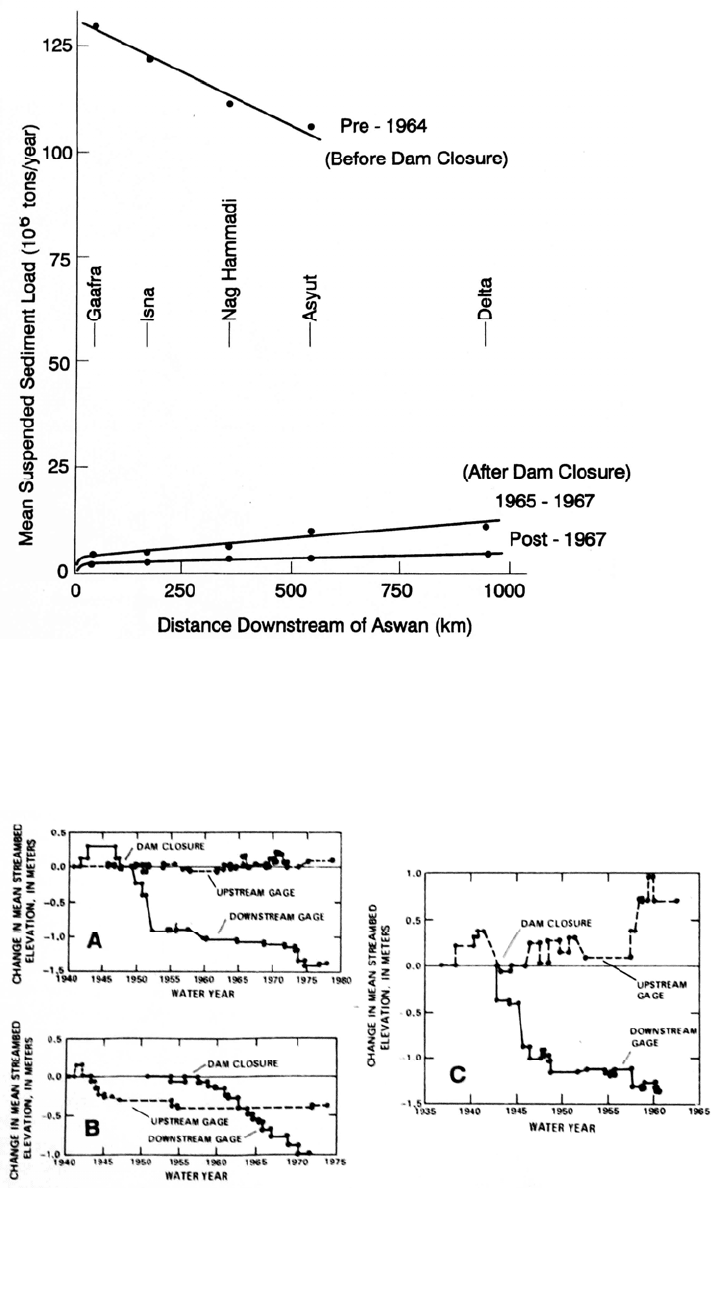
ENVIRONMENTAL AND REGULATORY ISSUES 18.12
FIGURE 18.7 Response of the Nile River to sediment trapping at the Aswan High Dam.
(adapted from Moattassem and Abdelbary, 1993). After dam construction the sus
p
ende
d
sediment load transported by the river was dramatically reduced, and the river's sediment load
now gradually increases moving downstream because of sediment entrainment from the riverbe
d
and banks. Sediment entrainment from the riverbed declines over time due to armoring. The Nile
has no tributary inflow downstream of Aswan.
FIGURE 18.8 Timewise rate of streambed degradation below dams, as compared to streambe
d
elevations above the dam. The location of the downstream gage is given. (a) Smoky Hill River
1.3 km below Kanopolis Darn, Kansas. (b) Chattahoochee River 4 km below Buford Dam,
Georgia. (c) Red River 4.5 km below Denison Dam, Oklahoma. (Williams and Wolman, 1984.)
ENVIRONMENTAL AND REGULATORY ISSUES 18.13
oth
ers.
Channel changes at gages both upstream and downstream of the reservoir were
plotted to separate dam effects from any underlying trends.
Streambed degradation will be limited by armoring, reduced peak discharges,
sediment inflow from tributaries, and grade control points along the bed such as bars,
bedrock, or artificial sills and barrages. The river below a dam will evolve toward a
new equilibrium condition, typically influenced by more than one of these factors. The
reduction in peak discharge not only reduces the rate of transport, thereby
prolonging the period of channel adjustment, but it will also reduce the size of
sediment required to armor the bed. The bed will degrade until enough coarse material
has been uncovered to stabilize the surface for the post-impoundment slope and discharge
conditions. Mathematical modeling is the most appropriate method for evaluating
these parameters and their impact on the evolution of the streambed below the dam.
In some cases, coarse sediment constituting as little as 1 percent of the bed
sediment may effectively control the bed profile, as in the Colorado River below Glen
Canyon Dam where the profile is controlled by cobble bars (Pemberton, 1976). For
example, Crystal Rapid in the Grand Canyon is created by a field of boulders and
smaller debris discharged by a small but steep tributary during storms. At high flows
(1600 m
3
/s) this formation produces gigantic standing waves and an adrenalin rush
for rafters.
Channel width can increase, decrease, or remain constant below the dam. In the
21 rivers studied by Williams and Wolman, channel width decreased by as much as
90 percent and increased as much as 100 percent at different cross sections.
Channels below dams are often affected by the encroachment of vegetation when
large channel-forming discharges are reduced or eliminated. Large flows are
necessary to scour sediments and vegetation from channels, and when flood flows are
reduced the channel width may also he expected to reduce in size, other things being
equal. Encroaching vegetation can block part of the channel resulting in reduced
channel conveyance, faster flow velocities in the channel thalweg, and greater channel
depth. On the Republican River in Nebraska, vegetation decreased the channel
capacity by 50 to 60 percent in some reaches. Examples of vegetative
encroachment below dams are illustrated in Fig. 18.9. The period of low flows
when a reservoir is initially filling may be particularly critical, since pioneer
vegetation can rapidly encroach onto bars and "lock" a formerly braided stream into
a fixed channel (Lagasse, 1980).
Ligon et al, (1995) described the reduction of the braided reaches of the McKenzie
River in Oregon as a result of flow regulation by two Corps of Engineer dams,
which have reduced peak discharges by over 50 percent. Channel simplification and
stabilization, with vegetative encroachment, has substantially reduced the area of gravels
suitable for salmon spawning. It has also reduced the area of sloughs,
backwaters, and traces of former channels created by meander cutoffs, habitat
required for rearing juveniles.
In the rivers studied by Williams and Wolman, the bed material initially coarsened as
degradation proceeded, but this pattern could change during later years. Armoring has
occurred in the reach immediately below main stem dams on the Missouri River, and
sediment size along the Mississippi River was also expected to coarsen as a result of
upstream dam construction, especially from construction of the dams along the Missouri
in the 1950s, its greatest sediment contributor. However, contrary to expectations,
505 samples at 417 locations along the river, taken by techniques and at locations
duplicating the extensive sampling performed in 1932, showed that thalweg sediments in
1989 were somewhat finer than in 1932 (Queen et al., 1991).
Although less common, the riverbed below a dam or barrage can also aggrade
as a result of dam construction. This can occur when a large sediment load is passed
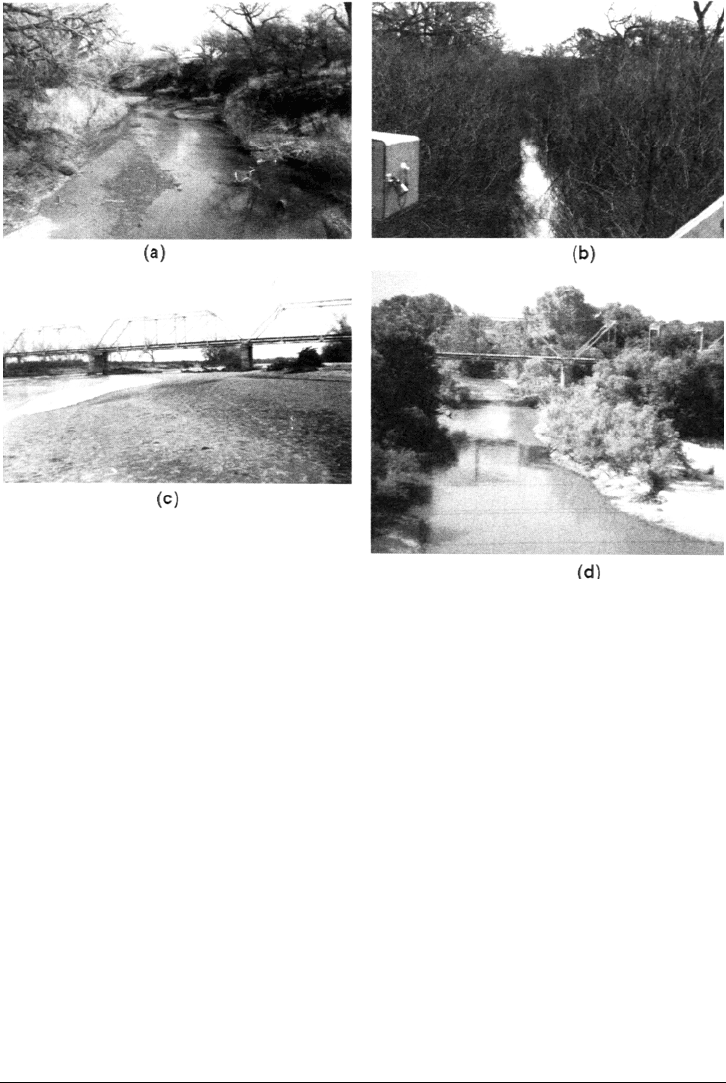
ENVIRONMENTAL AND REGULATORY ISSUES 18.14
FIGURE 18.9 Encroachment of vegetation into stream channels below darns as a result o
f
eliminating flood peaks which maintained the channel. Washita River 1.4 km below Foss Darn,
Oklahoma ia) in February 1950i, and IF) in February 1970. Foss Darn was closed in 1961.
N
orth Canadian River 0.8 kin below Contort Darn. Oklahoma 1c) in 1938, and 41) in 1980.
Canton Dam was closed in 1.948.
(
Wit/rams and Wohnou. I 984.1
do
wnstream but much of the water is diverted out of the river, or if a high concentration
flow is released at a low discharge rate as discussed in the Sanmenxia case study (Sec.
24.9). Deposition can also occur when tributaries below the dam deliver large
quantities of sediment, or large grain sizes, to a river which has reduced
discharge because of upstream dam construction. For example, deltaic deposits
have been formed where tributaries and arroyos deliver coarse sediment to the Río
Grande below Cochiti Dam, in northern New Mexico, because the regulated post-
impoundment discharges are generally not capable of transporting the coarser
sediment load and volume delivered to the channel below the dam. The coarsening of
the surface bed material along the Río Grande following construction of Cochiti Dam
is illustrated in Fig. 18.10. Farther downstream, below Elephant Butte Reservoir,
flow in the Río Grande is inadequate to transport even fine sediment, and the river
channel has gradually filled in (Fig. 18.11).
18.3 ENVIRONMENTAL IMPACTS OF SEDIMENT ROUTING
Sediment routing techniques (Chap. 9) can he used to mimic natural sediment flows
along a river while producing adverse environmental impacts that are small or negligible
compared to techniques such as emptying and flushing. Although off-stream reservoirs
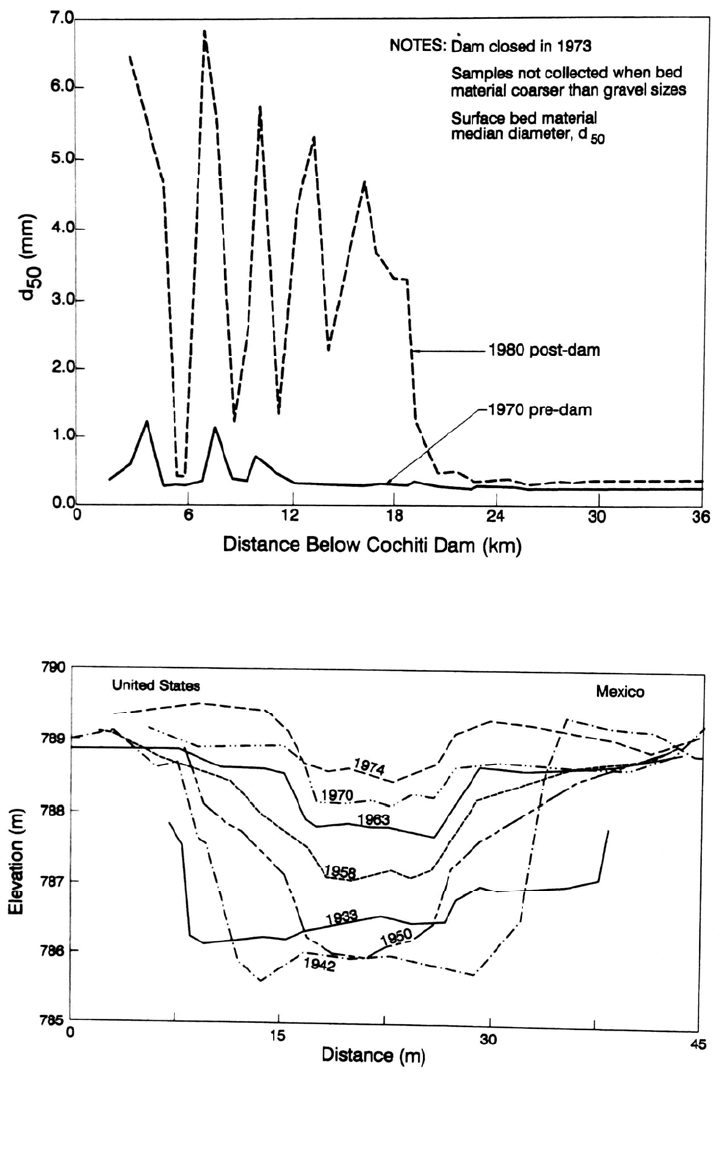
ENVIRONMENTAL AND REGULATORY ISSUES 18.15
FIGURE 18.10 Coarsening of bed material in Río Grande in northern New Mexico below
Cochiti dam resulting from trapping of sediment and reduction of peak flows by the dam, and the
continued delivery of coarse sediment by steep tributary arroyos along the river. (Lagasse, 1980.)
FIGURE 18.11 Narrowing and aggradation of Rio Grande at Presidio, Texas, as a result of the
dramatic reduction in flow shown in Fig. 18.2, combined with the continued input o
f
sediment from tributary arroyos. (Collier et al., 1995.)
ENVIRONMENTAL AND REGULATORY ISSUES 18.16
and sediment pass-through are well-adapted to reproducing many aspects of the natural
pattern of sediment movement, they are not without potential impacts.
8.3.1 Venting Turbid Density Currents
Passing the inflow of fine sediment through a reservoir as a turbid density current, which
is vented through the dam, can produce suspended sediment concentration below the
dam similar to that in the upstream inflow. In general this may be considered an
environmentally benign strategy since the suspended sediment concentration and
timing will be correlated to conditions above the pool. Because the turbidity current
normally passes through the reservoir in a relatively short period of time, the vented
current may remain oxygenated even though water within the reservoir hypolimnion is
anaerobic (recall Fig. 4.6). Nevertheless several limitations and potential problems are
associated with this technique.
Turbidity currents cannot transport coarse sediment under normal conditions,
and to release of a turbidity current will not solve downstream problems caused by the
lack of bed material. Turbid water may enter a reservoir during floods large enough
to mobilize and clean stream gravels. However, the turbidity current may be
vented from the dam at a discharge too low to mobilize downstream gravels.
Repeated releases of turbid rater without flows adequate to mobilize and flush
gravels will lead to the clogging of spawning gravels and water supply infiltration
galleries. This can be mitigated by releasing clear water at a discharge sufficient to
mobilize and cleanse gravels. If venting is initiated at a site where it was not previously
performed, the increase in turbidity as compared to the established post-impoundment
conditions below the dam may be considered an environmental problem, adversely
impacting users and aquatic ecosystems adapted to the clear-water condition below
the dam
18.3.2 Off-Stream Reservoir
A river intake diverts flow into an off-stream reservoir, while allowing floods to pass
the intake unimpeded. This type of reservoir maintains the continuity of bed material
transport along the river as well as the peak discharges below the dam. It also presents a
lesser migration barrier since the intake may consist of a low structure forming a pool of
quiescent water small enough that it will neither disorient migrating species nor
support a large population of predators. The intake structure should be designed to
minimize entrainment of migrating species, depending on the characteristics of each
river and the species of concern. For instance, river shrimp in the Caribbean use
estuaries as a nursery area, and the juveniles migrate upstream along freshwater
streams where they will mature and reproduce. The migrating juveniles, about 1 cm in
length, swim along the margins of streams where both current and predation is reduced.
An intake withdrawing water from one side of the stream hill entrain and kill half of the
migrants. In this environment an intake structure should be located at the center of the
stream to prevent entrainment of the migrating shrimp.
18.3.3 Seasonally Empty Reservoir
A. reservoir may be operated to supply water seasonally, remaining empty during the first
part of the flood season and allowing natural flood flows to scour and release sediment. A
single-purpose flood detention reservoir will be empty almost continuously, whereas
an irrigation reservoir may be empty for only a few weeks each year. This wide range
in possible operating conditions makes it difficult to make generalizations about the
impacts of these types of structures. A normally impounded reservoir having large low-
ENVIRONMENTAL AND REGULATORY ISSUES 18.17
level outlets and empty long enough to pass significant floods through the empty
impoundment with little attenuation (thereby preserving the transport of bed material),
may have relatively small impacts. Conversely, a normally empty flood control
reservoir which greatly attenuates downstream peak flows may trap a significant
amount of bed material and affect below-dam morphology. An irrigation reservoir
on a sediment-laden stream that is emptied for only a few weeks per year can produce
impacts very similar to sediment flushing.
A seasonally empty reservoir should be expected to produce water quality patterns
similar to any other reservoir emptying, but the magnitude of the downstream impacts
may be minimized by several factors: (1) the reservoir will trap less sediment during
the impounding period; (2) it can be emptied during a wet period when a large flow is
available for dilution and transport; and (3) anoxic bottom conditions may never
occur, thereby improving the quality of released bottom water.
18.3.4 Sediment Routing on Isar River
Environmental impacts from sediment routing may be caused not only by sediment
release, but also by contaminants released from the interstitial water in sediment deposits.
Two important contaminants associated with the discharge of reservoir sediments are
ammonia, which is lethal to aquatic life at high concentrations, and the biological and
chemical oxygen demand exerted by organic material and reduced chemical forms.
Westrich and Al-Zoubi (1992) describe the design and environmental mitigation strategy
for sediment routing through a low (7.6 m) hydroelectric dam on the Isar River in the
alpine area of southern Germany. This reservoir is about 150 in wide and 1800 m long
and the original riverbed slope was about 2.5 percent.
During 30 years of impounding operations, the 0.83-Mm
3
reservoir lost 43 percent of
its capacity because of the accumulation of sediments ranging in size from silts to
gravels. Streambed degradation below the dam lowered groundwater levels and
desiccated riparian wetlands in national parklands. It was desired to undertake sediment
routing to reestablish the pre-dam sediment transport pattern, but it was not desired to
flush a significant amount of the accumulated sediment out of the reservoir. Analysis of
sediments and pore water indicated the presence of several agricultural chemicals, but the
most critical limiting factors were considered to be high ammonium concentration (20
to 40 mg/L) in the interstitial water, the need to limit the increase in suspended sediment
concentration across the reservoir to not more than 5 g/L, and potentially high oxygen
demand by bacterial decomposition of organics plus the chemical oxidation of reduced
FE-II and sulfide compounds found in the sediments. The rapid first-phase oxygen
consumption rate in the water released from the dam was to be limited to 0.4 mg 0
2
/L
within 2 hours. A minimum pore water dilution factor of 100 was adopted to control
oxygen and ammonia levels. Surface sediment deposits in some areas of the
impounded reach consisted of silt size material that could be readily resuspended, and
it was also necessary to ensure that bed shear stress in these areas remained low
enough to minimize resuspension.
The objective was to approximately reestablish the morphology of the original river
channel along the length of the sediment deposits above the dam, enabling floods to
transport sediments along this channel without disturbing floodplain sediments. The
strategy adopted was to dredge (rather than hydraulically scour) a main channel through
the deposits. During flood periods, water level at the dam would be lowered about 2.5 in
to enhance transport capacity through the dredged channel, while simultaneously
reducing flow velocity and transport capacity over the submerged floodplain due to
shallowing of the water depth. To determine the alignment of the channel, the grain
size d
50
isolines were interpreted as transport capacity isolines within the reservoir,
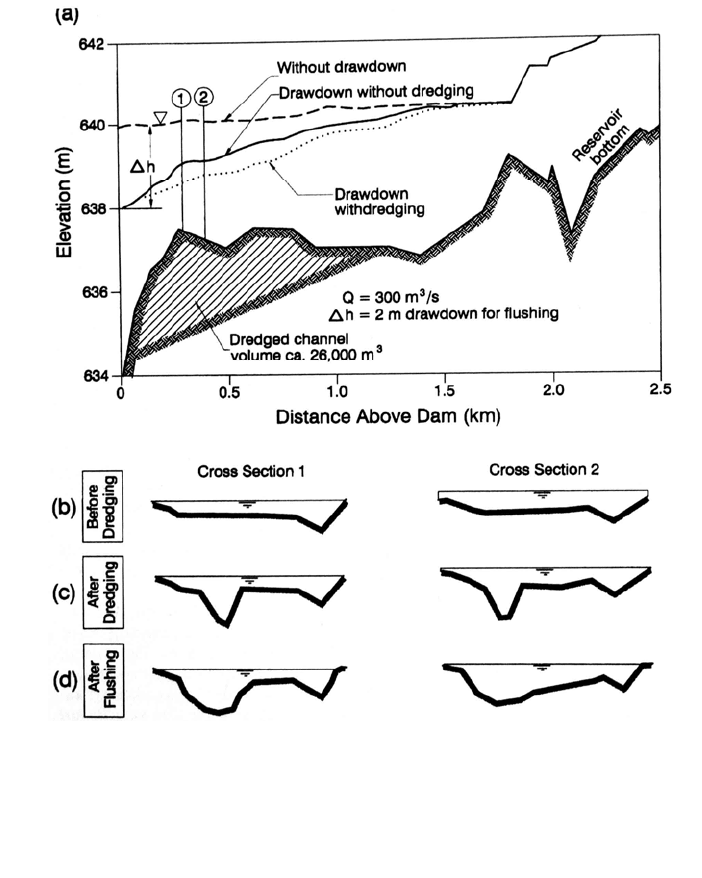
ENVIRONMENTAL AND REGULATORY ISSUES 18.18
and the dredged channel was located along the line of highest transport capacity as
identified by the largest-diameter material in the sediment deposits. This had two effects:
because the channel was dredged along the line of coarser sediment deposits, it reduced
the potential for erosion and entrainment of fines; it also placed the channel along the line
of maximum flow already developed within the impounded reach. The channel was
designed to gradually increase bed shear stress in the downstream direction. It was dredged as
a 10 m wide trapezoidal section with a bed slope of 2.5 percent to match the original bed
slope of the river, and 4:1 (horizontal:vertical) side slopes. The design discharge was 300
m
3
/s. A flood of 228 m
3
/s was passed through the completed system in June 1991 during a
12-h 2.5-m drawdown. Suspended sediment downstream of the dam increased by only 2
g/L, and dissolved oxygen levels remained near saturation. However, some erosion of the
bed occurred as a result of this event (Fig. 18.12) and about 26,000 m
3
of sediment was
transported out of the reservoir.
FIGURE 18.12 Channel for routing sediment through Isar River Reservoir, Germany. (a) Longi-
tudinal profile of reservoir showing the effect of drawdown on water surface profiles, and pre-
and post-dredging thalweg and water surface profiles. (b) Pre-flushing cross section. (c) Flushing
channel excavated by dredging. (d) Dredged channel modified by the first flushing event.
(Modified from Westrich and Al-Zoubi, 1992.)
